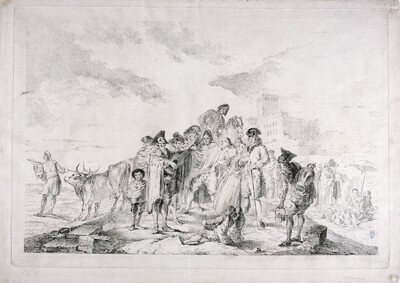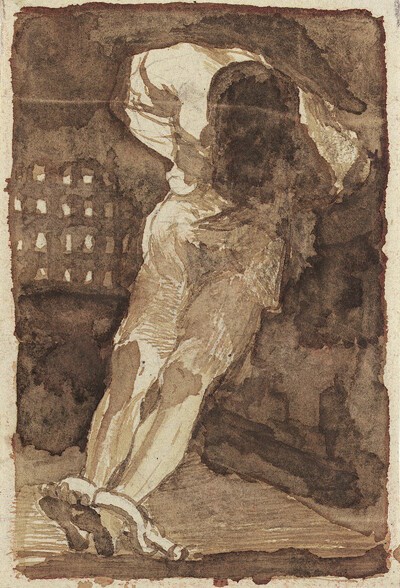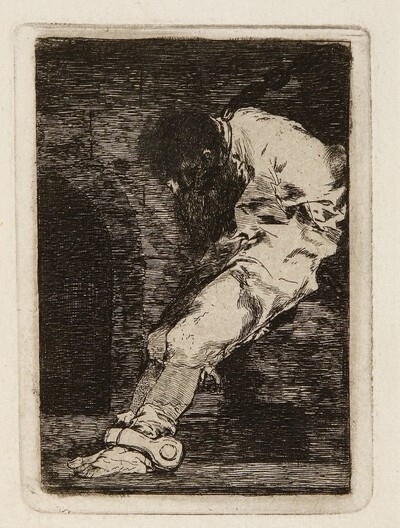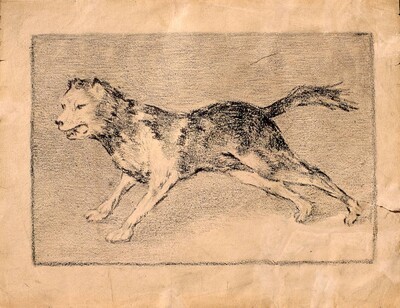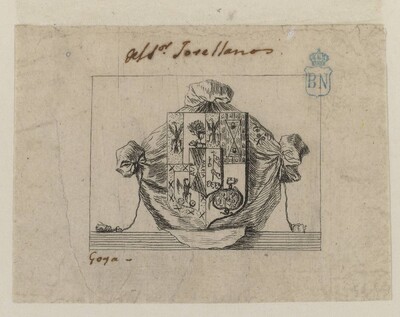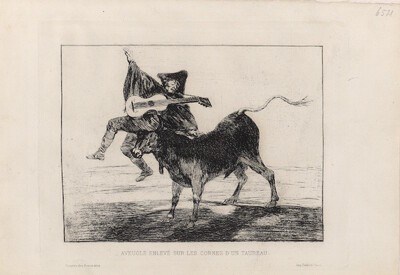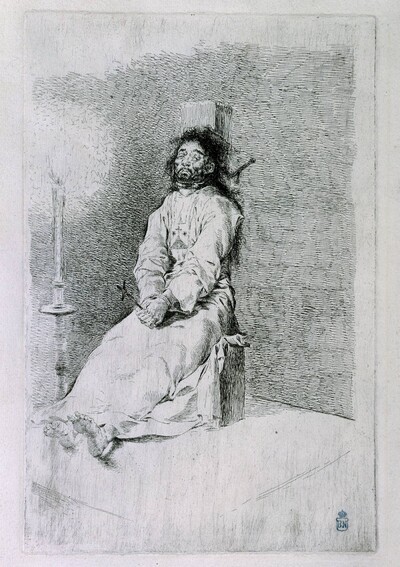- Cronología
- Ca. 1810 - 1815
- Dimensiones
- 115 x 85 mm
- Técnica y soporte
- Etching and burin
- Reconocimiento de la autoría de Goya
- Undisputed work
- Ficha: realización/revisión
- 16 Nov 2010 / 31 May 2023
- Inventario
- 225
- Otros títulos:
-
A prisoner seen from the front (Un prisionero de frente)
See The Blind Guitarrist and The custody is as barbarous as the crime.
The title of this work is taken from the handwritten title of a state proof that Goya included in the album of his Disasters of War prints which he gave to his friend Ceán Bermúdez and which is now in the British Museum, London.
The Museum of Fine Arts, Boston, has a preparatory drawing for this etching.
In this etching we see a prisoner, arranged diagonally in an unnatural, precarious posture. His face is hidden from view since he is looking down at the floor. His feet, held in large shackles, occupy the lower right-hand corner of the composition, whilst his head and his arms, tied behind his back, occupy the upper left-hand corner. The man is only able to rest his heels on the floor, forcing them to take the whole weight of his body. He is dressed in torn, ragged clothes, with most of his legs uncovered. In the background we can make out a barred window, through which only a tiny glimmer of light enters the cell.
Goya has constructed an extremely dark space using very tightly-packed lines, which have been applied diagonally for the floor and horizontally for the background. The light falls mainly on the prisoner's legs and left shoulder, as well as on his clothes, the brightness of which is an allusion to his innocence.
This etching must have been made at the same time as The custody is as barbarous as the crime and If he is guilty, let him die quickly, and can also be related to various prints from the Disasters of War series, in which Goya depicts scenes of prisoners condemned to death, clearly demonstrating his opposition to capital punishment. The title of this work is very clear on this point, with Goya pointing out that it is unnecessary to subject prisoners to such physical torture in order to prevent them from escaping.
The plate for this etching has been lost.
-
Exposición de la obra grabada de GoyaSociedad Española de Amigos del ArteMadrid1928catalogue by Miguel Velasco Aguirrecat. 45
-
Grabados y dibujos de Goya en la Biblioteca NacionalBiblioteca NacionalMadrid1946catalogue Elena Páez Ríoscat. 130
-
Goya en la Biblioteca Nacional. Exposición de grabados y dibujos en el sesquicentenario de su muerteBiblioteca NacionalMadrid1978May - June 1978cat. 134
-
Goya. Das Zeitalter der Revolucionen. Kunst um 1800 (1980 – 1981)Hamburger KunsthalleHamburg1980cat. 242
-
Goya y la Constitución de 1812Museo Municipal de MadridMadrid1982organized by Madrid Town Hall, consultant editor José Manuel Pita Andrade. From December 1982 to January 1983cat. 44
-
Goya grabadorMuseo del Grabado Español ContemporáneoMarbella1996from March 8th to May 5th 1996pp. 232-233
-
Goya artista de su tiempo y Goya artista únicoThe National Museum of Western ArtTokyo1999from December 1st to July 3th 1999cat. 263
-
Goya en tiempos de guerraMuseo Nacional del PradoMadrid2008consultant editor Manuela B. Mena Marqués, from April 14th to July 13th 2008cat. 120
-
Goya, grabadorMadridBlass S.A.1918cat. 263
-
Goya engravings and lithographs, vol. I y II.OxfordBruno Cassirer1964cat. 988
-
Vie et ouvre de Francisco de GoyaParísOffice du livre1970cat. 27
-
Catálogo de las estampas de Goya en la Biblioteca NacionalMadridMinisterio de Educación y Cultura, Biblioteca Nacional1996cat. 69
-
Goya en tiempos de guerraMadridMuseo Nacional del Prado2008p. 351

